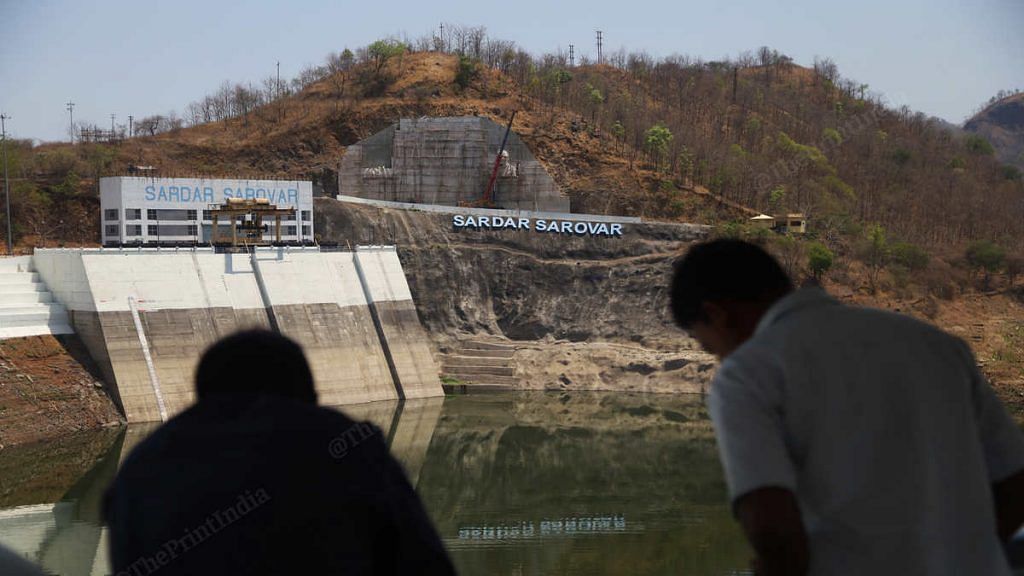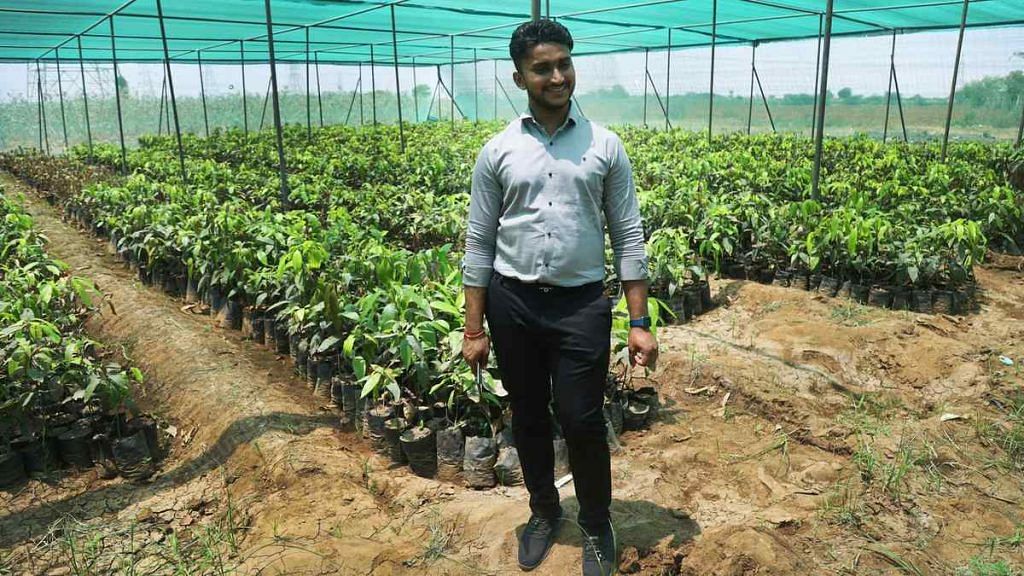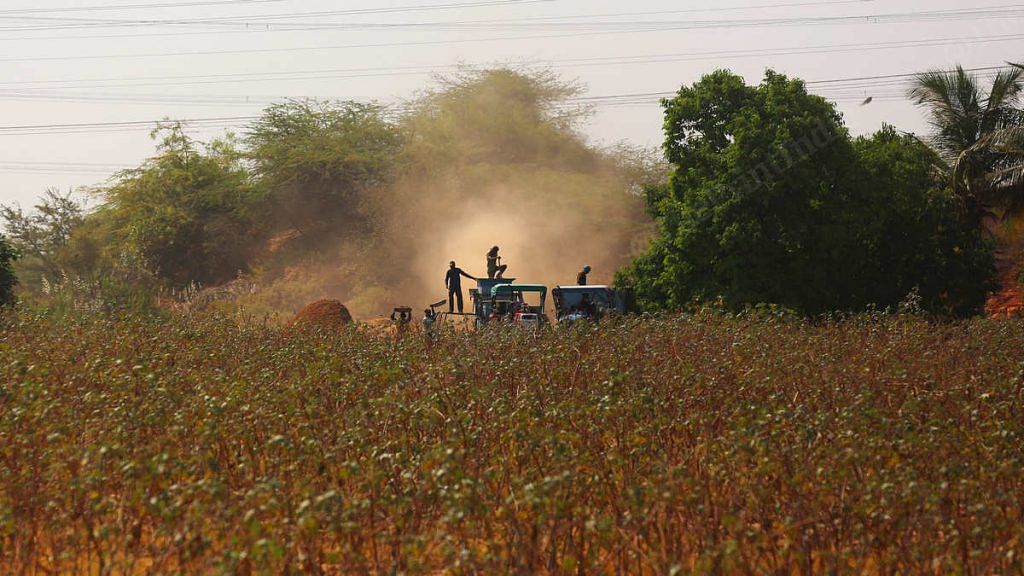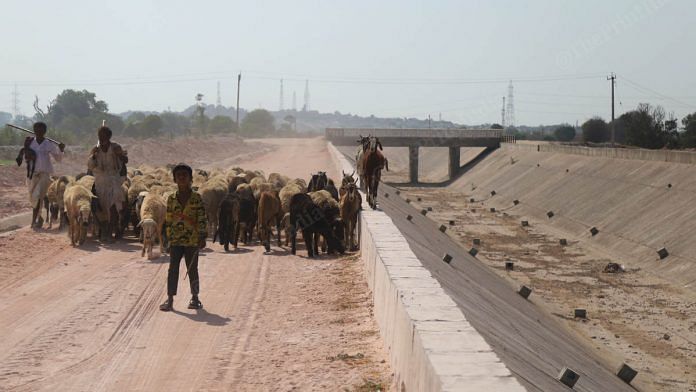Kachchh: Manilal Naran Patel used to feel a sense of dread whenever his son, a businessman in Maharashtra, called him over the phone. Give up farming, his son would say, urging his father to move in with him.
With groundwater levels receding, it has been difficult for Patel to irrigate his over 10-acre farm in Rayan Moti, a small village in Mandvi taluka of Kachchh, where he grows cotton, castor, pearl millet (bajra), and wheat. Not only must he pump water from a depth of 600 feet, its high level of total dissolved solids (TDS) has been affecting crop yield.
Now, however, Patel is hopeful that he will never have to move to the city, away from his beloved farm, since there is every indication that water from the Narmada canal will finally flow to his fields.
The last stretch of the 357-km-long Kachchh branch of the Narmada canal, part of the larger Sardar Sarovar project, is due to see the light of day soon, following years of postponements due to various factors, including a delay in land acquisition. It is finally due to be completed this month.
As of Sunday, 1 May, a dozen or so workers were busy completing the remaining 370 metres at a frenetic pace in Mundra and Mandvi.
Senior officials of the Sardar Sarovar Narmada Nigam Limited (SSNNL), the Gujarat government agency that is executing and operating the Narmada dam project, told ThePrint that Prime Minister Narendra Modi is likely to inaugurate the final leg of the project once work is completed either this month or in early June.
“Gujarat is one of the most water-stressed states of India and Kachchh is the thirstiest part of it. Today, the Kachchh branch canal is on verge of completion and water is about to flow freely in the region… We all feel proud and satisfied,” said Vivek Kapadia, director of SSNNL.
The farmers in the region are optimistic too, having heard about the success of the first stretch of the canal.
“It will be a dream come true for us. We have been hearing about how villages in other parts of Kachchh, like Bhachau and Rapar, have been transformed ever since canal waters reached their fields,” farmer Patel said, as he surveyed his fields. “I thought I wouldn’t get to see water from the canal reach my field during my lifetime.”
However, not all is hunky-dory. ThePrint visited Mundra, Mandvi, Bhachau, and Dudhai talukas in and around the Kachchh branch canal catchment area, and found that while many villages are reaping benefits, others are still waiting for their turn.
Also Read: Class 5 students as teachers, low attendance — Gujarat govt schools don’t paint ‘vibrant’ picture
What is the Kachchh branch canal?
The Kachchh branch canal is a part of the Sardar Sarovar Project on the Narmada River, which provides irrigation and drinking water to four states — Madhya Pradesh, Maharashtra, Gujarat, and Rajasthan.
The Sardar Sarovar Dam (also known as the Narmada dam), which is one of the largest in the world, can accumulate 28-million-acre feet (MAF) of water from the Narmada, of which Gujarat is supposed to get 9 MAF each year.

The cement-lined Narmada main canal is just over 458-km long up to the Gujarat-Rajasthan border, but also has an extensive network of branch canals for water distribution in its command area.
In all, the Sardar Sarovar project will provide irrigation facilities to 18.45 lakh hectare of land, covering 3,112 villages of 73 talukas in 15 districts of Gujarat. The project also supplies drinking water to 173 urban centres and 9,490 villages within and outside the command area in Gujarat.
The Kachchh branch canal, in particular, is expected to provide irrigation to 1,12,778 hectares of land in 182 villages in seven talukas of the district.
The first stretch, completed in 2015, irrigates fields in four talukas — Bhachau, Rapar, Anjar and Bhuj — and once the final leg is completed, Mundra, Mandvi, and parts of Gandhigam will benefit.
“The network of the Kachchh branch canal covers 357km… The last leg of KBC is under progress and we are planning to complete it by 15 May,” Vraj Pandya, executive engineer at the SSNNL, told ThePrint.
Throwing light on the challenges the project has had to face in Gujarat, Kapadia told ThePrint that the “most critical” issue in the interstate dispute over water-sharing was the height of the dam, or the full reservoir level of the Sardar Sarovar Project.
“Gujarat had laid a strong logical and legal foundation before the Narmada Water Dispute Tribunal in favour of the height of the dam as 455 ft RL as minimum requirement by placing forth the water scarcity in Kachchh and indispensability of a high reservoir level to supply water to the most deprived and far-off areas,” he said.
Increased crop yields, sharp rise in income
There is a reason why villagers in Mundra and Mandvi are looking forward to the completion of the last leg of the Kachchh branch canal: The glowing stories they have heard about the crops and farmers’ prosperity in areas where the Narmada’s waters have reached.
When ThePrint visited Bhachau taluka in Kachchh, where a stretch of the Kachchh branch canal became operational in 2017, many farmers said their lives had transformed for the better.
Bharat Vaid, a 23-year-old farmer, for instance, said that after decades of struggle, his family, which owns around 200 acres of land, is now prospering and even experimenting with growing new crops like dragon fruit, dates, and kesar mangoes in addition to the usual cotton, castor, and wheat.

Last year, Vaid, who has 45 farm labourers working in his field, claimed he made a profit of Rs 1.35 crore. “My input cost, which includes seeds, fertilisers, salaries of farm labour etc, is between Rs 40-45 lakh per annum,” he told ThePrint.
It’s a huge turnaround. A decade ago, Vaid’s father had only 20 acres of cultivable land and struggled to make a sustainable living.
“My father grew cotton, castor and wheat. But water was scarce. He was dependent on the borewell and the monsoon. He had to take out water from 550 feet below. The water quality was bad, which affected cultivation and yield,” Vaid said, adding that this elder brother moved to Mumbai so he could earn enough to supplement the family’s income. With the extra money, Vaid’s family bought more parcels of land over time.
The investment paid off after 2017, when one of the sub-canals of the Kachchh branch canal became operational and transformed irrigation in the field here.
“There has been no looking back since then,” Vaid said. In 2019, he joined his father in the fields after getting a diploma in agriculture from Lovely Professional University, Punjab.
“I started experimenting, introduced modern farm technology, and started growing exotic fruits besides the traditional castor and cotton,” he said. So far, it’s been a lucrative endeavour and he grows crops three or four times a year.
“There is enough water from the canal. The level of groundwater has also gone up because we don’t use borewells all the time now,” he said.
There are similar stories of newfound fortunes in villages across Bhachau, Rapar and Anjar.
According to figures available Gujarat’s agriculture department, the average yield of cotton has gone up from 624 kg/ha in 2006-07 to 1,080 kg/ha in 2020-21.
The yield of wheat, similarly, increased from 2,100 kg/ ha in 2010-11 to 3,204.77 kg/ha in 2020-2021.
“A rise in agricultural production has been reported across almost all the crops,” SSNNL director Kapadia said. “Agricultural production was 25.3 million tonnes in 2010-11, and in 2020-21, it went up to 46.573 million tonnes.”
Dry patches remain
The Kachchh branch canal might have transformed the lives of many villagers in the areas that it serves, but the benefits are not evenly spread.
Last month, PM Modi had appealed to the nomadic cattle-herding Maldhari community to settle down in Kachchh, since water and fodder was now available through the year. However, this is not true in every corner of the drought-prone district.

Not all villages come under the command area of the Kachchh branch canal, and many farmers still have to pump groundwater, which is not only scarce, but not ideal for cultivation due to salinity.
In some villages, groundwater must be pumped from below 600 feet. These farmers say their repeated pleas have fallen on deaf ears, and at this rate, they won’t have any option but to migrate outside Kachchh.
There are also villages that come under the command area of the Kachchh branch canal, but still don’t receive water because of the absence of distributary networks.
R.R. Patel, 75, a resident of Sikra village in Bhachau taluka, told ThePrint that he has 300 acres of land but can cultivate less than half due to paucity of water.
“I grow jowar and cotton. Three generations of my family were into farming. But now, I am the only one left here. My children have gone and settled in Mumbai because there was no income from farming. Without water, the yield in my field has gone down drastically,” he said.
According to him, people in his village are being deprived of water from the Kachchh branch canal because there is no distributary network. “No pipeline has been laid to carry water from the canal to our fields,” Patel said.
In nearby Devisar village in Anjar taluka, the problem is the same — not enough water. However, it seems even more insurmountable because the village does not come under the command area of the Kachchh branch canal.
Residents of Devisar are compelled go to adjoining villages to fetch water for drinking as well as irrigation. Shamjibhai Ahir, a Maldhari who owns 80 acres of land, where he grows fodder grass, jowar and castor, despairs about his prospects here.
“Our adjoining villages are getting water from Kachchh branch canal but we are being denied as our village does not fall in the project’s command area. How are we supposed to earn our living when there is no water?” he asked.
Every two days, Ahir has to go to Sikra with a private tanker to fetch water. “The tanker carries 4,000 litres of water and costs Rs 500. The water lasts us two days,” he said.

Earlier, he added, he could pump water from a depth of 500 feet, but now the level has gone down to 800 feet. “It is not sustainable anymore,” he said.
In the wake of protests from farmers and with Gujarat going to polls later this year, the state government has proposed to take water from the Kachchh branch canal through link canals and fill around 100 reservoirs in villages not served by the canal.
A senior official of the Sardar Sarovar Narmada Nigam Limited told ThePrint on the condition of anonymity that the proposed project, which is yet to get final approval from the Gujarat government, is worth Rs 3,500 crore. “The proposal is to take 1-million-acre feet of water from the branch canal to areas that are not covered by it,” the official said.
(Edited by Asavari Singh)
Also Read: In deadly dry Bundelkhand, Ken-Betwa link finally seems real. But critics have questions, fears



